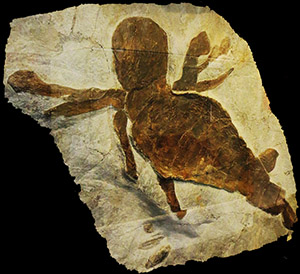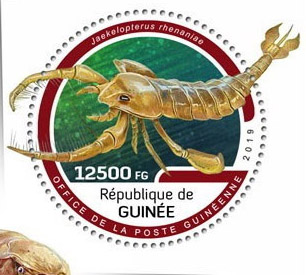Jaekelopterus rhenaniae Jaekel, 1914

(Da: en.wikipedia.org)
Phylum: Arthropoda Latreille, 1829
Subphylum: Arachnomorpha Heider, 1913
Classe: Eurypterida Burmeister, 1843
Ordine: Eurypterida Burmeister, 1843
Famiglia: Pterygotidae Clarke & Ruedemann, 1912
Genere: Jaekelopterus Waterston, 1964
Descrizione
Con una lunghezza stimata di circa 2,5 metri, questo animale è uno dei più grandi artropodi mai scoperti, insieme all’Arthropleura, simile a un millepiedi. Nonostante fosse uno “scorpione di mare”, il jaekelottero era probabilmente un abitatore dei laghi e dei fiumi e non viveva in acque salate. Come molti altri euripteridi, anche questo animale era uno dei massimi predatori del suo habitat: due lunghi cheliceri (parti dell'apparato masticatore simili a pinze) si protendevano di fronte al capo dell'animale e con essi afferrava i pesci corazzati che nuotavano. Un animale a esso simile, anche se di dimensioni leggermente minori, era il ben noto Pterygotus. Nel novembre del 2007 Simon Braddy e Markus Poschmann descrissero il ritrovamento di cheliceri lunghi 46 centimetri nella formazione Klerf. Le proporzioni dell'animale intero, basate su questi resti, erano davvero gigantesche.
Diffusione
È un artropode, estinto, appartenente agli euripteridi (o scorpioni di mare). Visse nel Devoniano inferiore (circa 390 milioni di anni fa), i suoi resti sono stati rinvenuti in Germania.
Sinonimi
= Pterygotus rhenaniae Jaekel, 1914 = Pterygotus howelli Kjellesvig-Waering & Størmer, 1952.
Bibliografia
–Braddy, Simon J.; Poschmann, Markus; Tetlie, O. Erik (2007). "Giant claw reveals the largest ever arthropod". Biology Letters. 4 (1): 106-109.
–Lamsdell, James C.; Legg, David A. (2010). "An isolated pterygotid ramus (Chelicerata: Eurypterida) from the Devonian Beartooth Butte Formation, Wyoming". Journal of Paleontology. 84 (6): 1206-1208.
–Lamsdell, James C.; Selden, Paul (2013). "Babes in the wood - a unique window into sea scorpion ontogeny". BMC Evolutionary Biology. 13 (98): 1-46.
–Tetlie, O. Erik (2007). "Distribution and dispersal history of Eurypterida (Chelicerata)" (PDF). Palaeogeography, Palaeoclimatology, Palaeoecology. 252 (3–4): 557-574.
–Plotnick, Roy E.; Baumiller, Tomasz K. (1988-01-01). "The pterygotid telson as a biological rudder". Lethaia. 21 (1): 13-27.
–Lamsdell, James C.; Braddy, Simon J. (2009). "Cope's rule and Romer's theory: patterns of diversity and gigantism in eurypterids and Palaeozoic vertebrates". Biology Letters. 6 (2): 265-9.
–Jaekel, Otto (1914). "Ein grosser Pterygotus aus dem rheinischen Unterdevon". Paläontologische Zeitschrift. 1: 379-382.
–Størmer, Leif (1936). "Eurypteriden aus dem Rheinischen Unterdevon". Abhandlungen der Preussischen Geologischen Landesanstalt. 175.
–Poschmann, Markus; Tetlie, O. Erik (2006-12-01). "On the Emsian (Lower Devonian) arthropods of the Rhenish Slate Mountains: 5. Rare and poorly known eurypterids from Willwerath, Germany". Paläontologische Zeitschrift. 80 (4): 325-343.
–D. Waterston, Charles (1964-01-01). "II. Observations on Pterygotid Eurypterids". Transactions of the Royal Society of Edinburgh. 66 (2): 9-33.
–Kjellesvig-Waering, Erik N.; Størmer, Leif (1952). "A lower Devonian Pterygotus from Wyoming". Journal of Paleontology. 26 (6): 997-998.
–Dunlop, Jason A.; Penney, David; Jekel, Denise (2015). "A summary list of fossil spiders and their relatives (version 16.0)" (PDF). World Spider Catalog.
–Gould, Gina C.; MacFadden, Bruce J. (2004-06-01). "Chapter 17: Gigantism, dwarfism, and Cope's rule: "nothing in evolution makes sense without a phylogeny"". Bulletin of the American Museum of Natural History. 285: 219-237.
–Briggs, Derek (1985). "Gigantism in Palaeozoic arthropods". Special Papers in Palaeontology. 33: 157.
–Kraus, O., Brauckmann, C. (2003-08-26). "Fossil giants and surviving dwarfs. Arthropleurida and Pselaphognatha (Atelocerata, Diplopoda): characters, phylogenetic relationships and construction" Archived 2018-09-09 at the Wayback Machine. Verhandlungen des Naturwissenschaftlichen Vereins in Hamburg. 40.
–Tetlie, O. E. (2008). "Hallipterus excelsior, a Stylonurid (Chelicerata: Eurypterida) from the Late Devonian Catskill Delta Complex, and its phylogenetic position in the Hardieopteridae". Bulletin of the Peabody Museum of Natural History. 49: 19-99.
–Kaiser, Alexander; Klok, Jaco (2008-06-23). "Do giant claws mean giant bodies? An alternative view on exaggerated scaling relationships". Biology Letters. 4 (3): 279-280.
–Braddy, Simon J.; Poschmann, Markus; Tetlie, O. Erik (2008-06-23). "Reply: giant claws and big bodies". Biology Letters. 4 (3): 281.
–McCoy, Victoria E.; Lamsdell, James C.; Poschmann, Markus; Anderson, Ross P.; Briggs, Derek E. G. (2015-08-01). "All the better to see you with: eyes and claws reveal the evolution of divergent ecological roles in giant pterygotid eurypterids". Biology Letters. 11 (8): 20150564.
–Elliott, David K.; Petriello, Michael A. (2011). "New poraspids (Agnatha, Heterostraci) from the Early Devonian of the western United States". Journal of Vertebrate Paleontology. 31 (3): 518-530.
–Poschmann, Markus; Schoenemann, Brigitte; McCoy, Victoria E. (2016-03-01). "Telltale eyes: the lateral visual systems of Rhenish Lower Devonian eurypterids (Arthropoda, Chelicerata) and their palaeobiological implications". Palaeontology. 59 (2): 295-304.
–Schoenemann, Brigitte; Poschmann, Markus; Clarkson, Euan N. K. (2019-11-28). "Insights into the 400 million-year-old eyes of giant sea scorpions (Eurypterida) suggest the structure of Palaeozoic compound eyes". Scientific Reports. 9 (1): 17797.

|
Data: 22/04/2019
Emissione: Animali preistorici marini Stato: Guinea Nota: Emesso in un foglietto di 4 v. diversi |
|---|